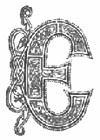Fences, Boundaries and Pillar-Stones in Ancient Ireland
From A Smaller Social History of Ancient Ireland 1906
« previous page | contents | next page »

Sculpture on Chancel Arch, Monastery Church, Glendalough; drawn 1845. (From Petrie’s Round Towers)
CHAPTER XIX.
AGRICULTURE AND PASTURAGE
SECTION 1. Fences.

VER since that remote time when legend and history begin to give us glimpses of the occupations of the inhabitants of this country, we find them engaged in agriculture and pasturage. For both of these purposes open land was necessary; and accordingly, the clearing of plains from wood is recorded in the reigns of many of the early kings as a public service worthy of special notice. But there was always more pasturage than tillage.
Farm Fences.—In very remote times, when the population was small and the land was mostly common property (as pointed out at p. 81, supra), there was little need for fences, and the country was mostly open, so far as it was free from forest and bog. But in course of time, as tillage gradually increased, and private property in land became more general, it was more and more necessary to fence off the portions belonging to different individuals. Fences are referred to in our oldest literature: and how important they were considered appears from the number of regulations regarding them in the Brehon Law. The general terms for a fence are ime, fál, and aile [imme, fawl, aule].
Four kinds of farm-fences are specified in the law:—First, a trench with the earth piled up on one side as a high embankment; a kind of fence still used all through Ireland: Second, a stone wall of dry masonry, which is still very general in stony districts in the west and south: the Third was formed of logs laid horizontally and securely fastened: the Fourth consisted of pointed stakes standing six feet above ground, and six or eight inches asunder, bound securely by three bands of interwoven osiers, and having a blackthorn crest on top.
Territorial Boundaries.—Fences such as these were too slight and temporary to serve as boundary-marks between large districts. Various landmarks of a more enduring kind were assigned for them in the law, some natural, some put down artificially. Among these are:—a "stone-mark," i.e. a large pillar-stone; a "deer-mark," namely, the hair-marks left by deer or cattle on the trees of a wood, or the hair-marked footpath made by them along a plain; a "water-mark," i.e. a river, lake, or well; a "way-mark," i.e. a king's road, or a carriage-road, or a cow-road (see chap, xxiv., sect. 1); a "mound-mark," i.e. a [great] mound or ditch or foss "or any mound whatever," such as that round the trunk of a tree.
Pillar-Stones and Ramparts.—That pillar-stones were regarded as an important means of marking boundaries is shown by their frequent mention in the records.
FIG. 166. Specimen of a 'Holed stone' (From Kilkenny Archaeological Journal).
We are told in one law-tract that when certain tribe-chiefs had taken possession of a district, they "erected boundaries or placed pillar-stones there"; and in another, that after land has been enclosed a hole is made in the ground on the boundary, into which is put "the chief's standing-stone, in order that his share there may be known." We have seen that a stone set up to mark a boundary was sometimes called a "stone of worship": corresponding with the pillar-stone god Terminus worshipped by the Romans (see p. 120).
Boundary pillar-stones are found standing all over the country. But pillar-stones were erected for other purposes, of which the most usual was as a monument over a grave (for which see chap. xxvii., sect. 5, infra), a practice that prevailed in Christian as well as in pagan times. Battles were often commemorated by pillar-stones as well as by carns and mounds. It has been already mentioned that pillar-stones were sometimes erected as idols. Many of the standing-stones still remaining have a hole through them from which they are commonly called "holed-stones"; but the use of these is a mystery (fig. 166).
Pillar-stones are called by several Irish names:—coirthe [curha]; gall; gallan; and legann. As to many or most of the pillar-stones now remaining in the country, it is often hard or impossible to tell, in individual cases, for which of the above-mentioned purposes they were erected.
Many of the great mounds or ramparts also still exist: and there is generally a popular legend that they were rooted by an enormous enchanted black pig. One of the largest of all is that in the valley of the Newry river, which separated the sub-kingdoms of Oriell and Ulidia. Great artificial dividing dykes are found in every part of the world, some historic like the Roman wall in Britain, and some prehistoric. Offa's Dyke dividing England from Wales is a grand example: but the most stupendous artificial dyke in the world is the great wall of China.

